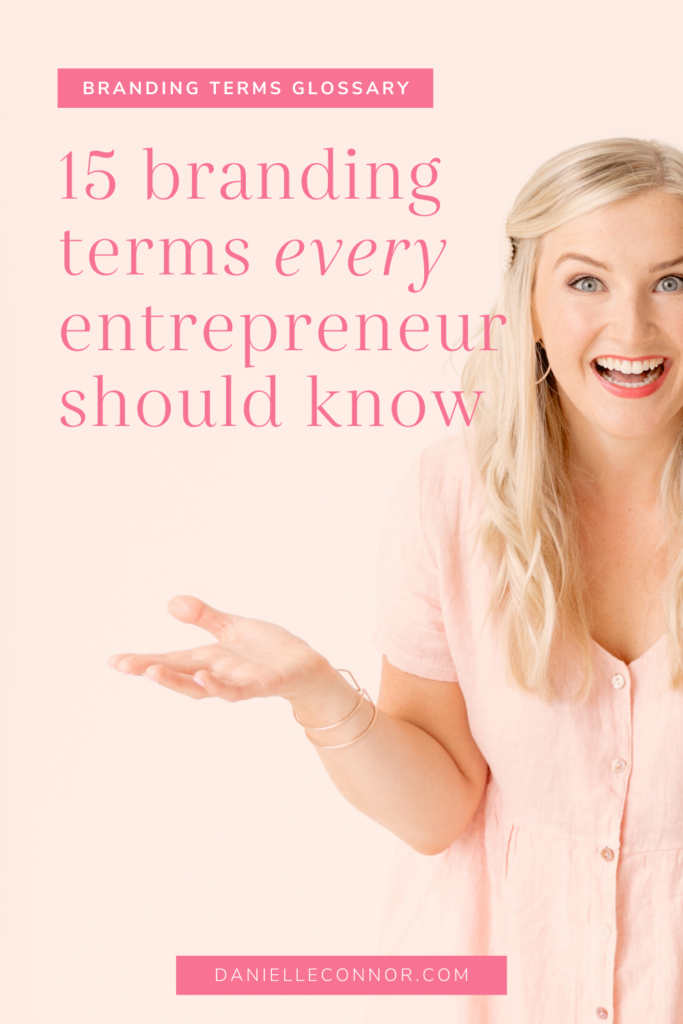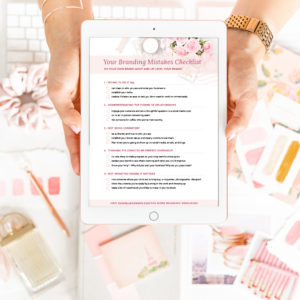Have you ever gotten lost in learning something new and are bombarded with terminology that you don’t understand? I know I have! So that’s why I want to help you with a branding terms glossary and answer the age old question of what is branding?
Being an entrepreneur and running a small business can be overwhelming! That’s why I try to make branding as clear, easy, and fun as possible. So check out these 15 branding terms that every entrepreneur should know when running their business.

General Branding Terms
1. Brand
One of the most important branding terms to be crystal clear on is your brand. It is who you are and how you express yourself as a business to your target audience. It encompasses everything from how you show up in person, to your photos, to how you speak or write (and is so much more than just your logo!). It’s how you make your audience feel when they interact with you and your business. Your brand is what people say about you when you’re not around.
2. Marketing
Marketing is the short-term approach of how you are going to reach your target audience and what tactics you plan to use along the way. It is how you promote yourself and connect with your clients. It is converting leads into sales by using tactical strategies and actions across your website, emails, and social platforms.
3. Visual Identity
Your visual identity is how your brand comes to life visually, through fonts, colours, photography, and your logo. Your brand encompasses your visual identity. Remember, your visual identity is one element of your brand – an important one! – but not your entire brand.
4. Brand Spirit + Personality
A set of 3-7 words that describe the look, feel, and essence of your brand. These could be “bold, playful, feminine”, or “calm, grounded, and nurturing”. Your brand spirit is one of the first things you create when bringing your brand to life. It helps you stay on track as you create your mood board, pick fonts and colours, and design your logo.
Visual Identity Terms
1. Mood Board
Your mood board is a curated selection of images that speak to your brand spirit and personality. I recommend finding 7-10 images that visually represent your brand (I love using Pinterest for this!). Afterwards, you’ll use your mood board to then pull your colours, fonts, and overall style from. It’s also a great tool to give a photographer ahead of a brand shoot or use during your website design process.
2. Color Palette
A colour palette is a collection of 5-7 colours that you’ll use across your brand and visual identity. Ideally, you have a range of dark and light colours, so you can use darker colours for text (so it’s legible!), and lighter colours as accents or backgrounds. Use your mood board to pull your colour palette from so you create a cohesive, consistent visual identity.
3. Logo
First things first, your brand is WAY more than just your logo. Your logo is not your brand. Your logo is one “small” part of your brand. Depending on your business the importance of a logo can vary. Ideally you have 2-3 versions of your logo. One with your full business name, an icon version (could just be a letter, or a graphic), and a third one whether that’s a simplified version (eg. a different layout, another colour) or a more detailed version (eg. including a tagline). Your logo brings together all your other brand elements (fonts, colours, spirit + personality) with your business name, and you get to use it across your brand touch points!
4. Fonts + Typography
Typography and fonts are the way your letters look! Fonts all have a personality, and can make your audience feel a specific way, so use that to your advantage. Channel your brand spirit and mood board and make sure you’re choosing fonts that are bringing to life your cohesive brand. Fonts can be very formal and simple, or they can be bold and playful! Have fun bringing this to life! Check out this blog post loaded with some great tips on how to pick fonts for your brand!
5. Brand Shoot
A photoshoot for your brand! I’m always saying how important photos are – they can make or break your website! Photos matter. No if’s, and’s or but’s. Scheduling a brand shoot with your photographer to get a selection of photos that you can use across your website and social platforms is important. You want more than just three photos of you smiling at the camera. Variety is key so that you can speak to different elements of your brand and business!
Other Branding–Related Terms
1. Touch Points
This is one of the more forgotten branding terms but I believe it to be an important one. These include any point where your clients/customers come in contact with your brand or business. This can be your Instagram account, an email you send them, your business card, a physical storefront, or your website (just to name a few – but there are loads!); any place where your brand makes contact with your ideal client. It’s an opportunity for you to build the know, like, and trust factor with your audience and develop relationships with your future clients!
2. Brand Asset
A brand asset is similar to a touch point, in the sense that it’s somewhere your audience engages with your brand and business. Your website, photography, or print materials would all be brand assets. Again, an opportunity to create and build connections with your ideal clients through these different assets that speak to your brand and business.
3. Brand Audit
A brand audit is a chance to review the different aspects and elements of your brand and find opportunities to improve. For example, if you’re doing an assessment of your Instagram page, ask yourself these questions: are the photos “on brand”? Have you started to veer away from images that speak to your brand spirit? Are you starting to use too many colours that aren’t part of your brand colour palette? Or, if you are doing a full deep-dive into your website and looking at why it might not be converting your ideal clients, ask yourself these questions: are your calls to action clear? Is it easy for your audience to find what they’re looking for on your site? Is your website showcasing your personality? Taking the time to see where you can increase your conversion rate across your brand assets is super important and valuable!
Download a copy of my branding mistakes checklist and start your brand audit today!

4. Landing Page
A landing page is a page of your website (or another platform like Mailchimp, ConvertKit, Leadpages), where your audience can join your newsletter, download a freebie, sign-up for a webinar or join a course waitlist. Landing pages usually only have one call-to-action on them and don’t have anything else to draw your audience’s attention elsewhere. For example, the landing below only mentions my branding blueprint freebie sign-up, you can’t get to anywhere else on my website from it. So there’s no chance of my audience getting distracted, and I’m making it super easy for them to snag the freebie (which is what they were probably looking for in the first place!).

5. Sales Page
A sales page is anywhere you’re selling a service or product, whether that’s a 1:1 service or an online course. Some sales pages require more content (eg. a high-ticket group coaching program) as they’re a bigger investment, while others can be a bit shorter and sweeter. Above all, you want to make sure you include clear descriptions, bullet points highlighting what’s included, the investment and/or payment plans and testimonials. Make your sales pages fun, engaging, easy to navigate/read – and don’t forget your clear call to actions!
6. CTA or Call-to-Action
A CTA is a call to action, an opportunity to invite your audience to take action on your website, social post, email, or another point of contact. They’re what are going to convert your audience into paying clients and customers. This is the “hook”, where you’re going to draw your audience in. You want to get them excited, and make them want to take that action! Most importantly, you want to make your call to action irresistible to click and easy to take action on so your future clients/customers don’t even have to think twice! It’s such a no-brainer next step to take that action! Need some help brainstorming some creative CTA’s for your website? Check out my blog post on website call to action best practices here!
Now that you are crystal clear on the most common branding terms I’m sure you feel like a branding whiz! Have fun using these terms as you apply them to your new business or revamp your existing online business!
Be sure to follow me on Instagram and share your branding journey with me! I love cheering on other small businesses and female entrepreneurs!

